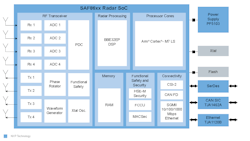3D Radar Taps Advanced Signal Processing for ADAS
This video is part of the TechXchange: Automotive Radar.
What you’ll learn:
- Why 3D radar is important to ADAS and software-defined vehicles.
- How NXP’s SAF86xx SAF86xx radar SoC simplifies antenna deployment.
Advanced driver-assistance systems (ADAS) and software-defined vehicles (SDVs) require a significant amount situational awareness to operate safely. Radar is one of the sensors that provide reliable environment details, but these applications really need 3D radar.
NXP’s SAF86xx radar system-on-chip (SoC) single-chip RFCMOS radar solution leverages advanced signal processing to minimize the number of antennas needed to provide a 3D radar image (see figure). It accomplishes this feat using distributed aperture radar (DAR). Increasing the aperture improves recognition of objects of different sizes moving at different rates.
I talked with Matthias Feulner, Senior Director of ADAS at NXP, about the company’s latest 3D radar technology (watch the video above). The SAF86xx can handle short-, medium- and long-range automotive radar applications.
The SoC has a set of four transmitters and receivers along with the ADC, phase rotator, and low-phase-noise VCO. The analog analysis is handled by the BBE32EP DSP. An Arm Cortex-M7 provides overall system management. It’s linked to a host processing via a gigabit Ethernet port.
The family supports ISO 26262 and ASIL Level B functional-safety standards as well as the ISO/SAE 21434 security standard. The MACSec engine and HSE-M security hardware support is designed to mitigate cybersecurity risks.


